PostaArt: an interview with a violin maker Vladimir Kalashnikov
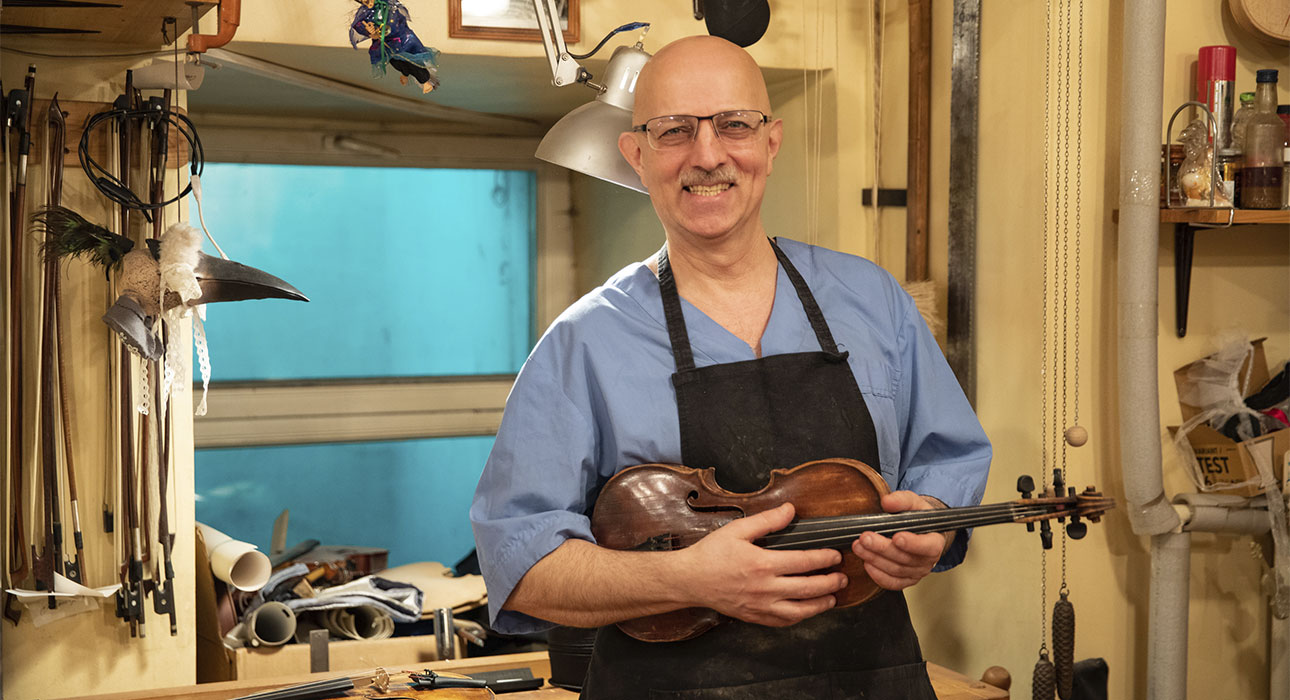
The luthier Vladimir Kalashnikov is the follower of the traditional Italian school of musical instruments production. His teacher Denis Yarovoy inherited his knowledge from the famous Giuseppe Fiorini, who belonged to the line of violin makers going up to Giuseppe Guarneri – the best apprentice of the great Stradivarius.
Vlada Litvinova: Violins are made in France as well as in Germany. Why has the Italian school become the world standard?
Vladimir Kalashnikov: It was Italy where the making of musical instruments was developed to the utmost level of skills, the sheer absolute. It is believed that these instruments sound most pleasantly for the human ear. However, at each school there were their own geniuses and losers. But most people want to have an Italian violin even if a French one sounds better in their arms.
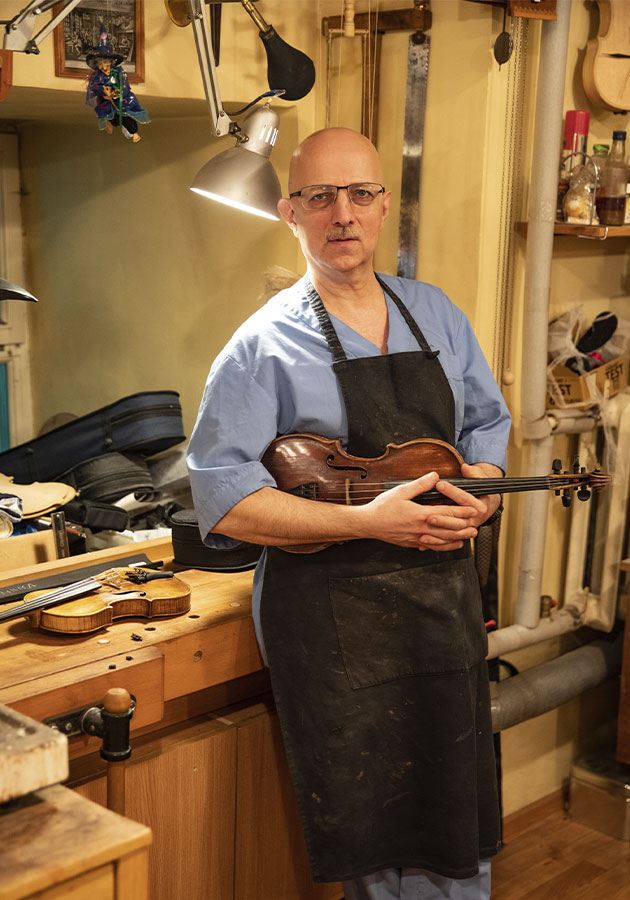
– The secret of Stradivarius’ violins is reported to be discovered every week. So, what is the secret?
– I don’t like the word “secret”. It’s a technology which was used by the Italians and which turned out to be the most productive one – the total plates tuning. The idea of the method is the following: for each note possible to be played by the instrument there should be found a spot on it which ideally resonates with the same frequency. In the moment of resonance, it should reach the pinnacle and catch up the whole plate. So, each centimeter should be tuned on both plates’ surfaces taking into account all possible notes which can be played on the instrument.
If violins were made of plastic, it could be possible to find one best combination and replicate it. But violins are made of wood, which is an unstable material. There are no two identical pieces of wood in the world. The Italian genius was in devising the technique which was applicable to any quality of timber. Those masters were able to extract beautiful sound from the simplest material, not from the most expensive one. Obviously, for a top-class instrument production the material is important: it should be beautiful and elegant. But for the magnificent sound the cost of timber is not the key factor.
– Nowadays, authentic performances are getting popular, when musicians play the instruments of the corresponding epoch. What is the difference between a Baroque violin and a contemporary one?
– Everything has changed: stress, materials, tension. During the Baroque times a violin’s neck was different, attached to the plate at a different angle. It had gut strings and a fingerboard made of soft types of wood. As soon as the strings with high tension appeared – metal, synthetic – the shape of a neck had changed. Metal strings were destroying soft fingerboards and the craftsmen had to switch to dense black wood.
Also, the instruments sounded differently. Those ancient violins which we hear now were remade in the XIX century according to the new standards. Nobody can be sure that they know how an original Stradivarius violin sounded. There are the authentic instruments in some museums, but I have never got a chance to hear them.
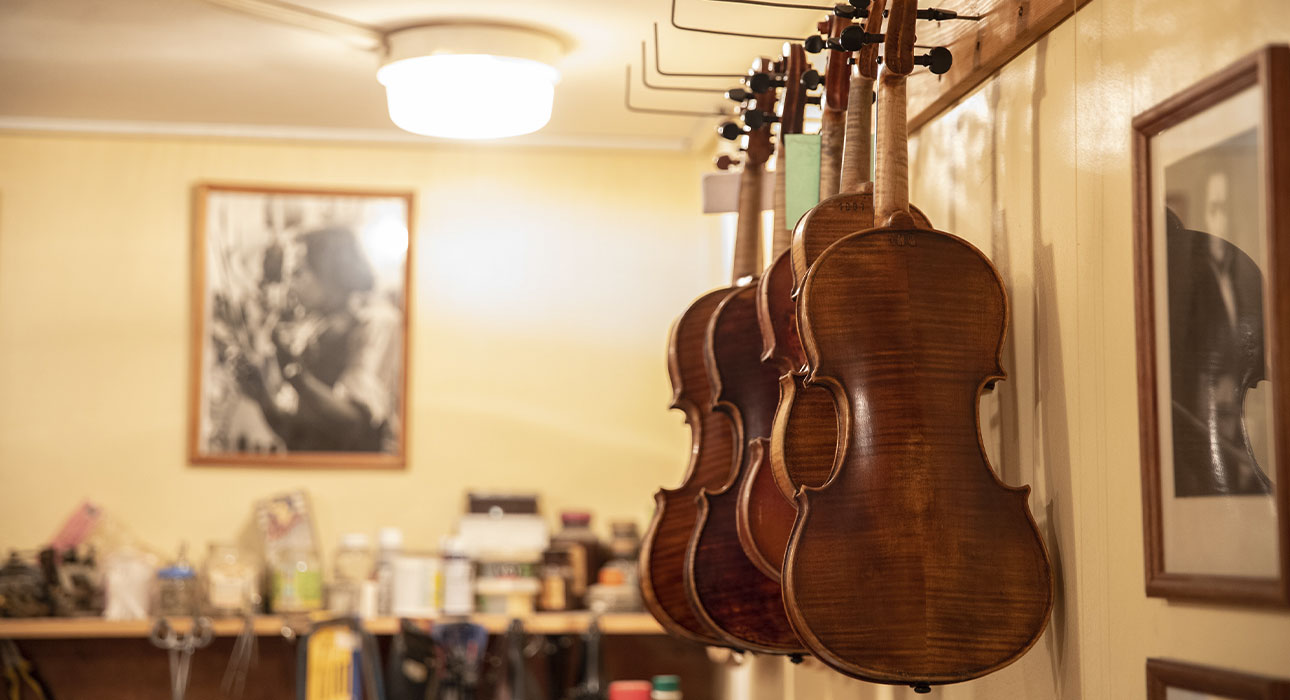
– Does playing the ancient instruments kill them?
– To my mind, the ancient instruments are working at their top abilities. They are challenged in ways their creators could not expect or predict. There were no halls for thousands of seats which were necessary to fill with sounds. The violin music was played in tiny spaces of churches and chambers. The fact that the ancient instruments are still working is another proof of the genius of their creators. But some instruments still die failing to cope with the modern workload and stress.
– Does a violin have a lifespan?
– It is hard to give an exact number. We have well-sounding pieces of work by Amati and even Gasparo da Salo, which dates back to the XVI century. The wood decay period is 70 years: if you keep an ordinary piece of dry wood under good conditions, it will turn into pulp by the end of this time. To save the instruments they are primed and conserved to protect from any outside influence – to prevent moisture penetration or chemical reactions. If a violin is well cared for, maintained, and kept in ideal circumstances similar to the museum's, it can live almost forever. It is not a secret that the most serious harm to an instrument is done by a musician. If an instrument is being exploited, there is inevitable wear and tear. An ancient instrument can be easily broken tomorrow if the owner of it just accidentally slips on the ice. That’s why the approaches to instrument restoration for museums and for active usage are so different.
– If an ordinary musician is given a famous instrument, will he or she play much better?
– It’s a common illusion. Can you drive a car? If you get hold of a Formula-1 bolid, will you drive far? It’s the same story with expensive instruments: you should know how to deal with them. A top-quality instrument requires a high level of professionalism of the musician. A novice will not feel the potential of the instrument and most definitely will not be able to realize this potential fully. Moreover, they can damage the instrument: a violin adapts to the musician and starts sounding in the way it is demanded, so it starts sounding worse. To return proper sound to a violin is not a simple task.
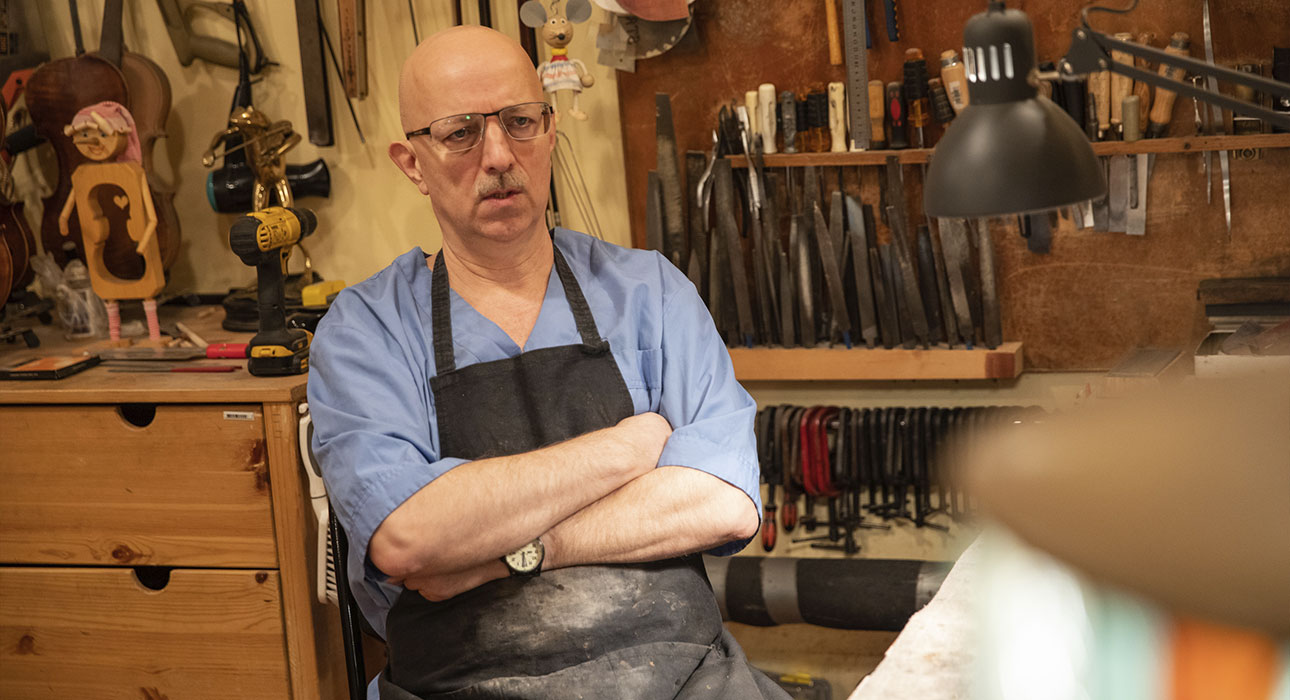
– Then why do the instruments which are over 300 years old and have changed so many hands sound so beautifully?
– At all times there have been masters and instruments of different levels. As a rule, an instrument made by a top-class craftsman would never not end up in the hands of a beginner as it was not affordable, it had a different image on the market. Most often such instruments have spent their time in the hands of professionals. And each of these talented musicians has had their impact on the instrument. The violin has been improved during all those 300 years – it was well taken care of: brought to the masters, maintenanced, regulated, tuned and played on. Inevitably its sound has become gorgeous. If I were taken care of in the same way by the best doctors and cosmetologists, I would probably look better than the others. Simpler instruments, manufactures, produced at the same time are in a bad condition. Nobody loved them and so they have fallen apart.
– Is it true that even Stradivarius made violins of different quality – simple ones and real masterpieces?
– Craftsmanship is not something you get as you are born, each master acquires thier experience gradually, learns and at the start of the career makes simpler violins. So not every violin of Stradivarius is ingenious. There were also the instruments produced by his team: simple work was done by the apprentices and then the master finalized them. This is the way I was taught by Denis Yarovoy: I made plates and the teacher tuned them, showed how to do it properly. As a result, we got an instrument with perfect sound but simple appearance because it was made by an apprentice.
Yarovoy had a lot of “bland” violins, but the best were taken abroad immediately. “The only one who never makes mistakes is the one who never does anything”. It is possible not to sign your instrument, but at the moment of production you are sure that you have done a really good violin. I sometimes meet my violins of the 90s and, from the current point of view, I understand what can be improved and changed. However, musicians play these violins and they are happy. I have changed the varnish on some of my instruments just because there were no such good materials at those times.
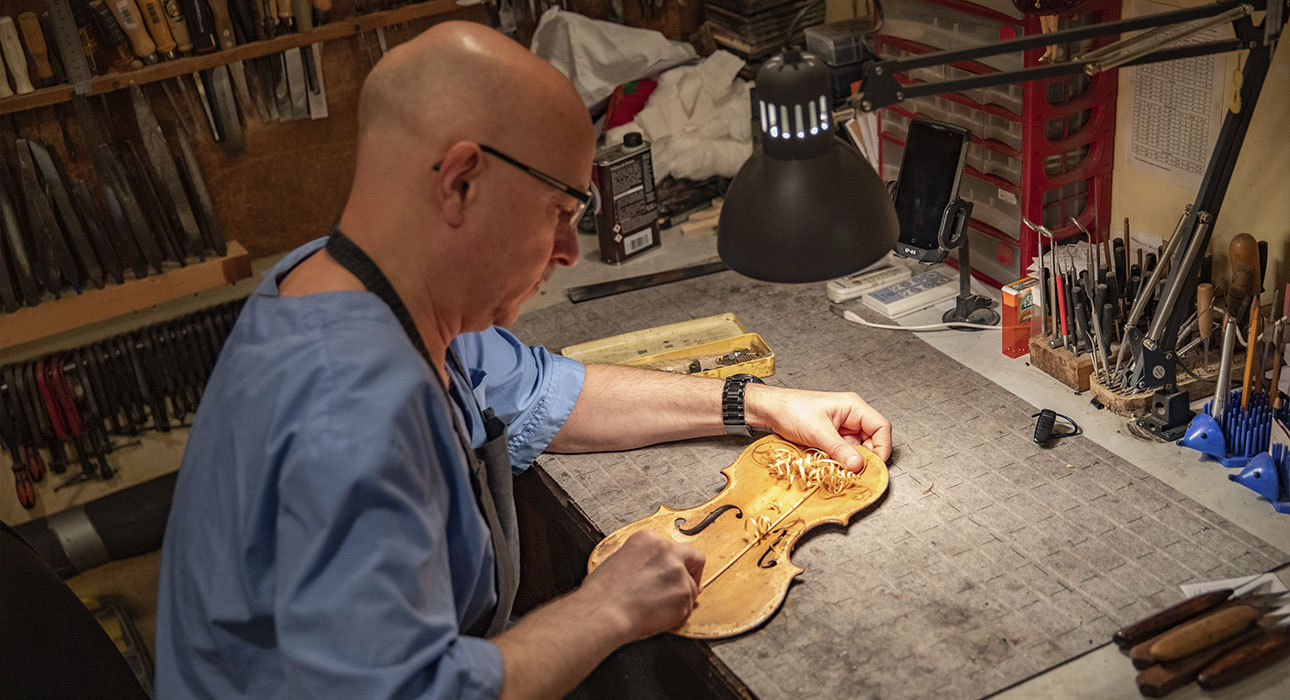
– Do luthiers make their best instruments during the last part of their life?
– Sure. Have you ever seen a genius 20-year-old cardiac surgeon? As a matter of fact, they are all over 60. It is a really painful situation – you are at your peak, know everything, can do everything but here the health problems turn up and you can not work as you used to. This is what happened to my teacher: his last years he had severe aches, nothing could alleviate them, so he damaged his own instruments. If there is some permanent pain, it is hard to stay in contact with reality. He was still sure about his actions, but they were actually not that right. So, we, the apprentices, would pull the instrument out of his hands when we saw that it was at risk.
– How long does it take to make a violin?
– It depends. Technically it is possible to make it during a couple of weeks plus some time to let the varnish dry. At American and European schools masters can assemble a nice box during a week. But it is the sound which is the indicator of talent, knowledge and experience. My best violins are those, which I was making slowly, during about four months. There is one feature which is not often taken into account: when you saw a piece of wood, some of its internal tension is released. And this tension should settle down, come to a specific state. You carve, cut the unnecessary parts, and at each stage the wood should lie and rest. That was exactly the manner of the Italian masters: do something with one instrument, then switch to another. I always work with several violins at the same time at the workshop: one is being varnished, another one is in clips, the third one is just at the start of the creation process. It is impossible to make three violins a month with such an approach, like some masters do, although the result is more stable.
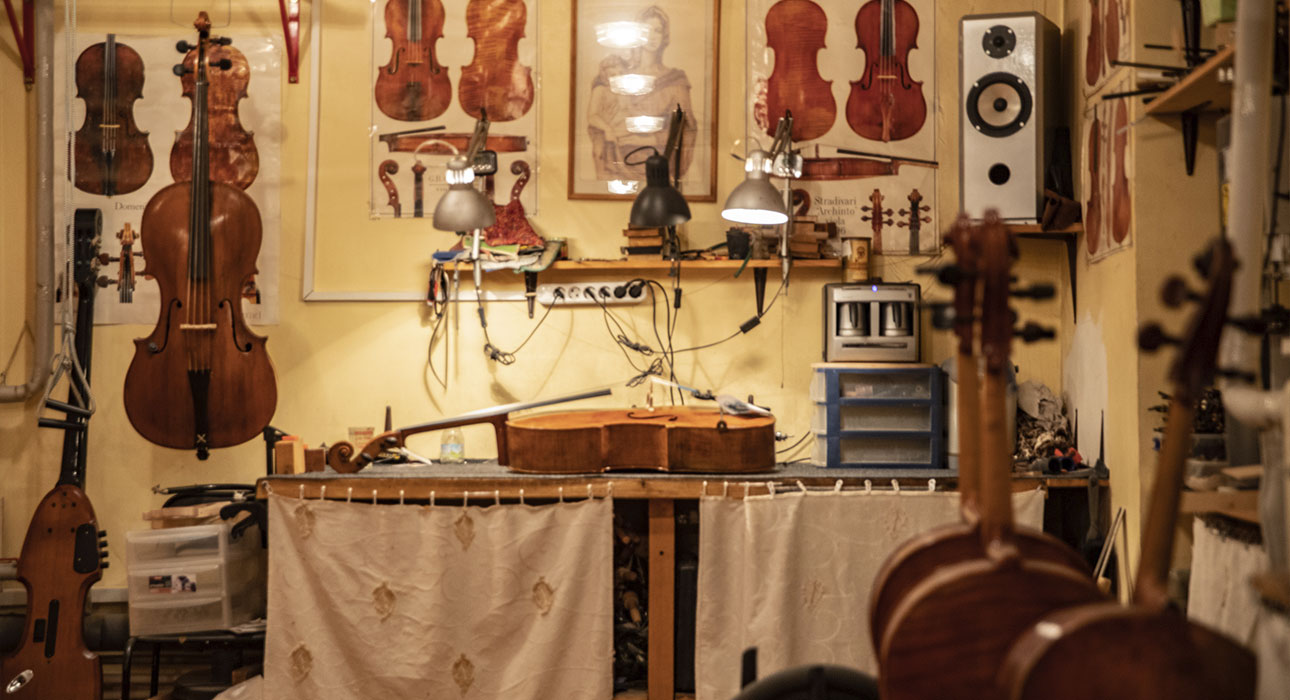
– At Gnesin Russian Academy of Music there was launched a program for musical instruments restoration. You work as a violin maker and as a restorator. Do you think it is possible to specialize in only one of these professions?
– It is a major dispute, which has been all over the world for a long time. There is an opinion that a master should be either a narrow-niche restorator or a violin maker. I disagree. How can you restore something you have never made by yourself? And how can you create an instrument if you have never looked inside of an ancient one? Besides, a violin maker should be good at playing the instrument, have musical education. There are a lot of artisans who can not play the instrument and just copy templates. They could as well make harps, drums or cars on an assembly line.
– If the “secret” total plates tuning technique has been known for such a long time, why don’t all masters use it?
– It is complex, it requires education and practice. It is necessary to spend five-six years training your ears to hear very specific things, besides you have to be a musician. There were no spectrographs, tuners or sound analysers before. People did everything with their own hands and ears and I am a follower of those conservative techniques. My teacher Denis Yarovoy used to say: “At first, you learn how to do an operation in the way it was done at those times, with those tools and using those approaches. When you have learned how to do it brilliantly, you are welcome to mechanize.” What is the point in spending half a day sawing out a plate if you can do it in a minute by an electric jigsaw? But at first you should learn how to cut it out manually. This is the major difference of the Russian school: we were able to carve anything out of a log. For example, a hand-made violin bridge is a sign of high-level craftsmanship and is very prestigious. The things which we had to do manually in the Soviet times just due to the lack of tools now are presented as special hand-made objects.
– Is there a difference between an instrument made by a luthier and the one produced at a factory?
– What would be more pleasant for you: if you were presented with a necklace produced at a plant or created by a jeweler? A handmade instrument is different, it is “warmer”. A man is not a robot and can not do everything absolutely precisely and symmetrically, there are always some flaws. But these are the inaccuracies of a certain human being, the result of the personal mannerism, hands movements and vision, these are the things which give the instrument its unique timbre.
A machine can make an ideal box, but due to the instability of the material - the wood - it is still unable to tune the sound as well as a human being can. Globalization resulted in the average understanding of the sound of a violin. I have set an experiment: when students come to me to choose an instrument, I give them both Stradivarius and Guarneri, but they do not like the sound of them. Today it is necessary to sound bright, “glassy”, loud enough for a big hall. These are the types of the instruments being produced in large numbers by European masters, the ones which are in high demand of the wide audience.
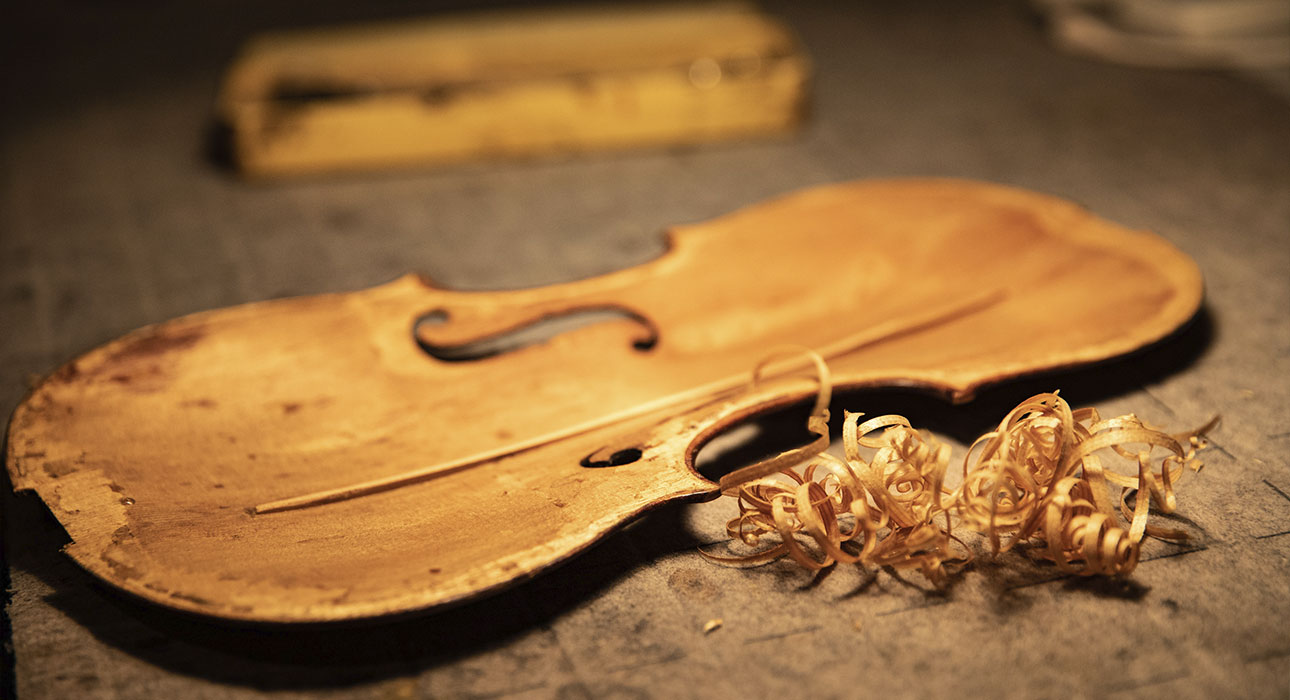
– Don’t musicians hear the difference?
– Musicians have almost no chance to hear such instruments live. Just a couple of times from a distance in a concert hall. However, masters have this opportunity every day. There have been a lot of experiments with blind hearing: Stradivarius violins are somewhere at the 10th place. A musician is able to recognise the luthier by the sound of an instrument, but this must be a very knowledgeable and experienced person.
– Does this mean that people at the concert do not hear the difference between a Stradivarius and a more simple violin?
– Only professionals are able to hear it. If the playbill does not say that there is a Stradivarius, 90% of spectators will not identify it. It is something for a musician to be proud of and for a music lover to admire. It is like in any sphere: someone is into it and someone is not. For example, I do not like alcohol, but there are people who can name the country, the slope of the grapes origin and the year of the wine just having made a gulp of it.
– If there are just a few who hear the difference, why does everyone want a Stradivarius?
– It will always remain like this. Even if tomorrow they announce that violins with the same sound will be produced by a plant, musicians will still be dreaming about an ancient instrument and masters will keep looking for the secrets of making.
– You picked up your skills personally from hand to hand. Do you have any successors?
– There is a constant flow of people who would like to become my apprentices, but I have no opportunity to teach them. I need a bigger space, separate rooms. During the Soviet times there were no certificates of luthiers, so I can not give an apprentice a professional qualification.
There has always been great interest in the profession, and during the last five years a lot of new masters have appeared. Luckily, there are opportunities now to go abroad and study in Cremona, in the US. In Gnesin RAM there will be a course for musical instruments restorators. Glinka Museum of music has organized outstanding master-classes of foreign specialists. I would love to study, but the age limit does not allow me to. I would like to polish my skills, but someone needs to study from scratch, so this is a way for the young.
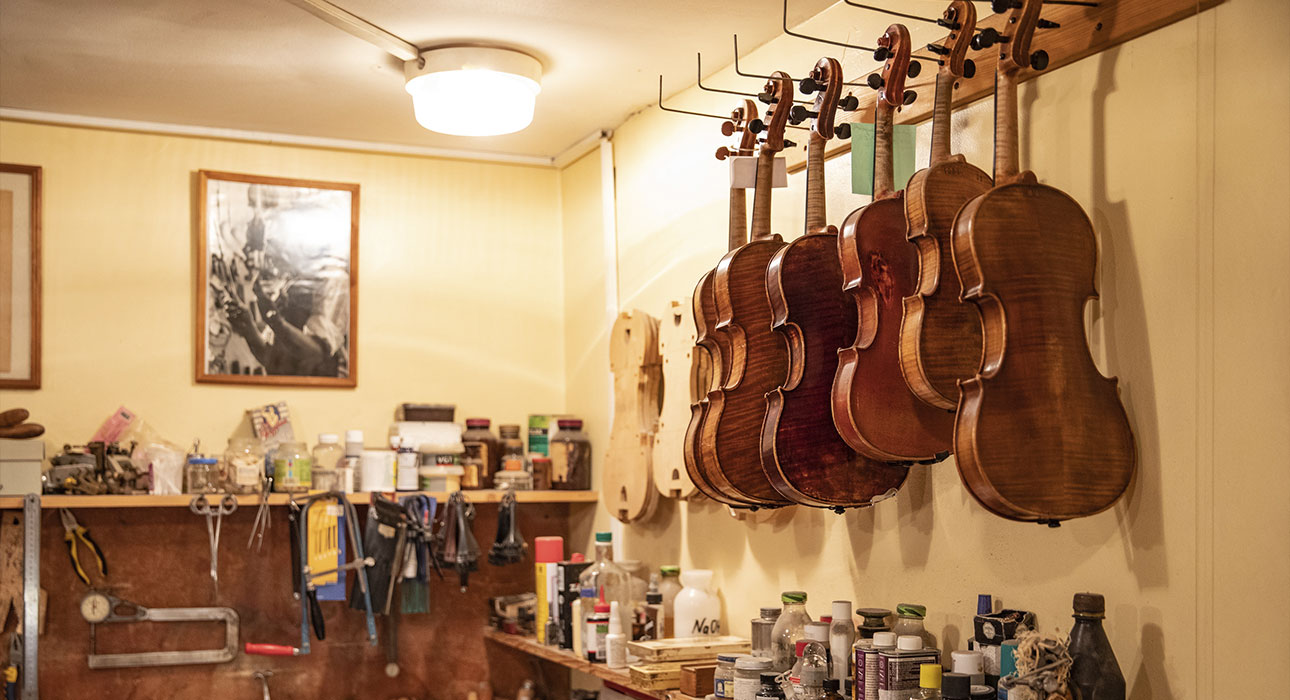
– It is a medical shirt you are wearing, isn’t it?
– Yes, it is a surgical suit, it is the most comfortable clothes for work. It is breathable, weightless, easy to wash. Sometimes I joke that my job is similar to a pathologist’s – I open up the instruments. Like in medicine, there is the major principle of restoration – do no harm. There is a special term – reversibility of restoration. New technologies and new solutions appear every day. Maybe the things which now take half a year will be able to be done much better during a week. There should be a chance to change. That’s why we never use synthetic glues, only water-based ones – to keep the chance to soak and remove each piece.
– Are you a craftsman or an artist?
– I’m definitely an artist, mood and state are crucial for me. I make a new violin only in a good mood, in a bad one I can only do simple repair work. In the restoration it is possible to set tasks for the day, but the creation process is different. There is a popular idea that a master puts his soul in the instrument. I was told that my violins are recognisable. If you play them, you can clearly hear that they were made by Vladimir Kalashnikov.
I never make a violin without a purpose, only for a specific person and for specific reasons, then I got inspired. Inspiration – it does not always have a female image, it might as well be some news or a solved task. I had a case: I had nearly finished a cello, was going to varnish it, but gave up. Two years it remained in that state, and then suddenly something happened, someone told something and I broke through, set aside all restoration work, apologized to the clients and finished the instrument.
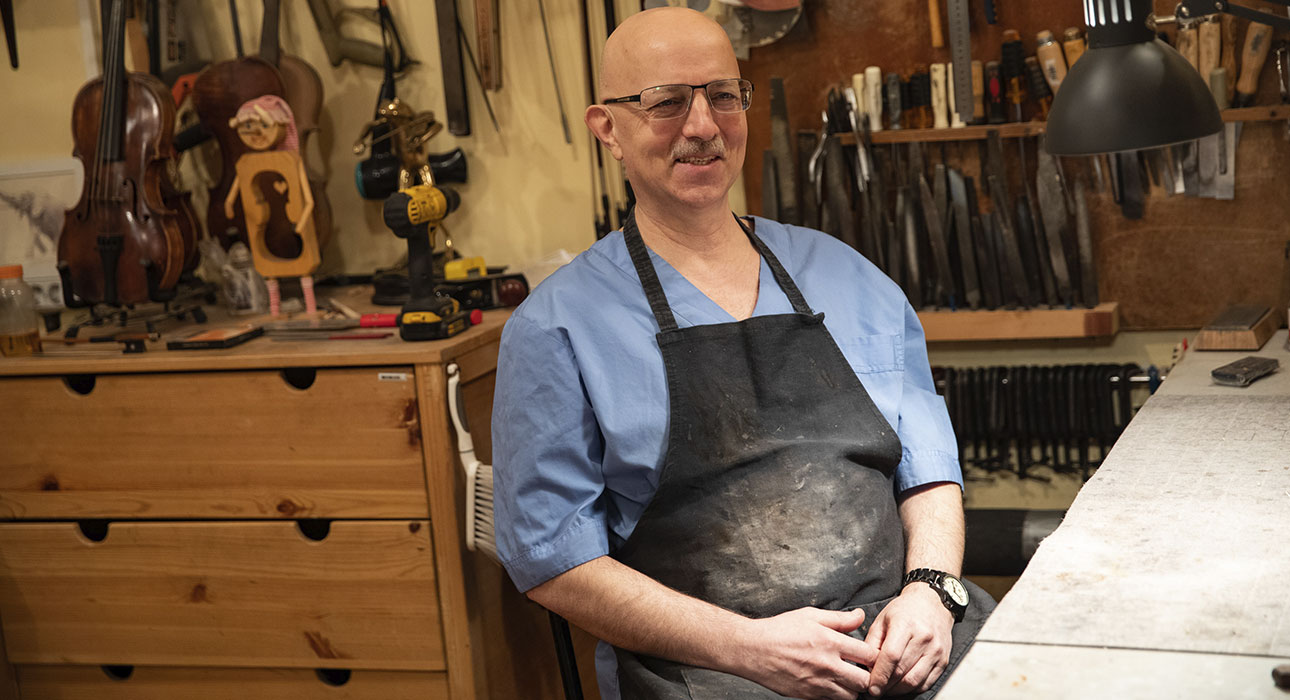
– Would you rather make violins or restore them?
– Actually, there is no difference for me. There are no two identical restoration processes, the same type of a crack on different violins require different tools and approaches. It is impossible to glue something today exactly as you did it yesterday. I’m solving new tasks all the time and this is really interesting.
If you do repair work you have to communicate with a large number of people of all kinds – from the crazy to the genius. It is necessary to be psychologically stable and capable of talking to all of them. My productivity was the highest at the exhibition Art in Action where I had got a specially built workshop. I was not distracted by any calls or clients, the visitors were just standing and looking at me working. I had completed the work for a week in two days.
In the process of making a new violin there is some work with the plate vaults: you're sitting in the twilight, with the light of just a table lamp, and checking the shadows. Nice music is playing and this is all so cozy. But the plates tuning is always quite demanding for the brain. I can do it for only two or three hours and then have to switch to the restoration.
– Can you predict how your violin will sound in about 20 years?
– I can. But it depends on the way it is being cared for and used as well as where it is taken to. That’s why I prefer my instruments to be owned by professional musicians. A violin is not just a simple thing made of wood, it is very delicate and is always under huge pressure. A minor change in humidity or temperature affects both the sound and the whole construction. Even a door in a country house is easy to open in winter and hard in summer. And a violin is under tension – the whole construction is under the strings’ pressure of 36 kg. The most frequent problems of the instruments are those caused by the change of climate zones.
I know where about five or six of my instruments are in Russia, but the rest are all over the world: in Slovenia, Japan, the US. Musicians go on tours, settle down, sell and resell the instruments. Any instrument can be presented and lost. Some of my violins were stolen, but one of them was found and returned to the owner.
– How much do violins cost today?
– There is a wide range of prices. I have seen violins for $20 which were quite appropriate for work. The cost of violins at auctions can reach millions. It is quite difficult to evaluate your own instrument, it might seem to you that it is made ingeniously, so an independent expertise is necessary. Every new instrument I give to different great musicians to play during a month. It is a hard job, but they do it for me. They listen to the violin, try to play, and then I collect the opinions of at least ten musicians, which obviously appear to be very different. It is necessary to pay more attention to the repeated comments, like if one string sounds quieter than the others. After that the instrument is fine-tuned and regulated, then it is played in different halls and at last it becomes clear what kind of violin has been created.
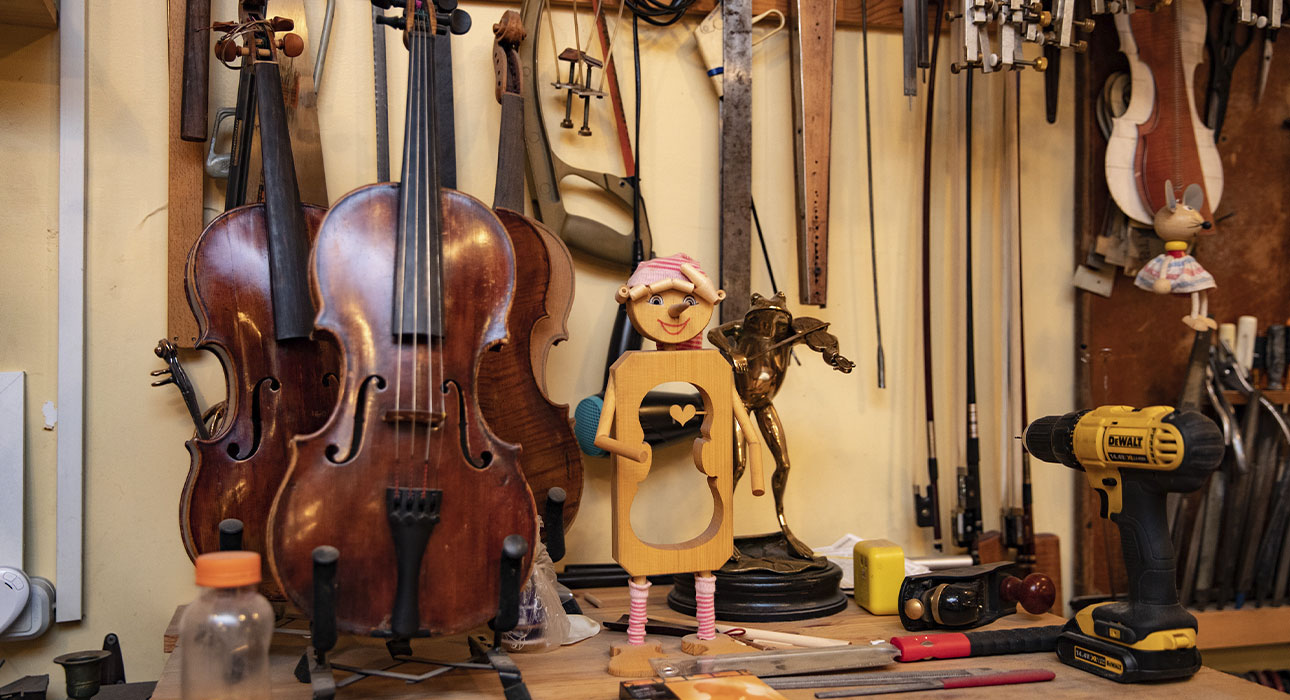
Interviewer: Vlada Litvinova
culturologist and the author of the Telegram-channel: “Theater girl’s notes”
Photographer: Yan Koomans
Translator: Natalia Mayorova
Source: Posta-Magazine


